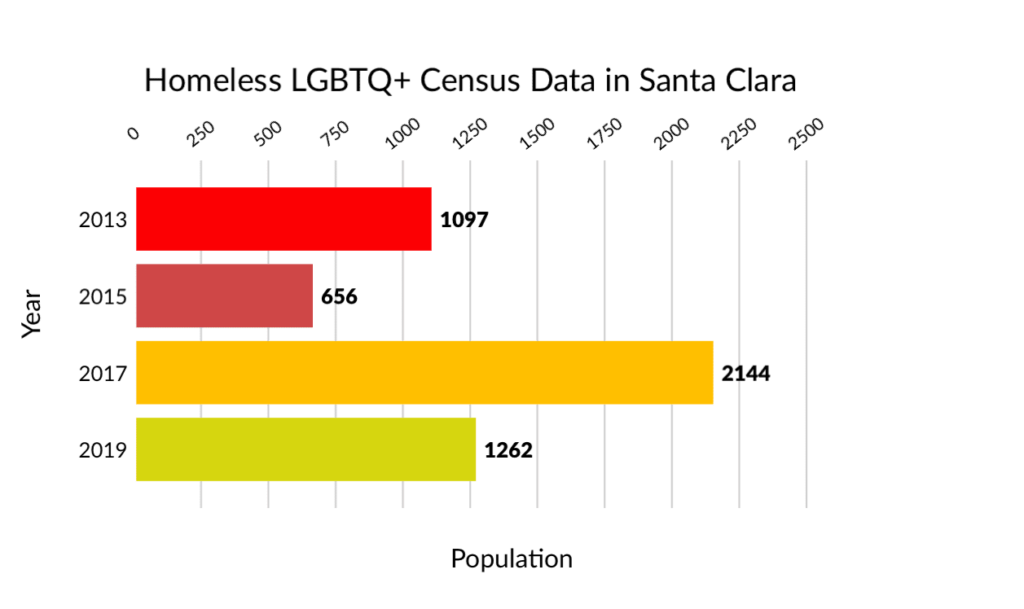The number of people estimated in the latest countywide homeless census to be LGBTQ+ dropped dramatically — from 2,144 in the last survey in 2017 — to 1,262 in January of this year.
What should be good news is instead a baffling statistic for people in the community who know they experience homelessness at a higher rate than the rest of the population. It doesn’t make sense, they say, that the total number of homeless individuals in the county jumped by more than 2,300 while the population of LGBTQ+ homeless people dropped by almost 900.
But those figures, released last week in the county’s final report, came with a caveat.
“Gathering data on gender identity and sexual orientation on hard-to-find populations like youth and young adults can pose difficulties,” the 2019 report cautions. “Past years have made every effort to be as representative as possible, but caution should still be used when interpreting past data around gender identity and sexual orientation.”
This is only the fourth time Santa Clara County has asked about sexual orientation and gender identity in its biennial homeless count and survey. The first was in 2013 when 7,631 homeless people were counted and 856 responded to the survey. Extrapolating from there, the company hired by the county to analyze the data, Applied Survey Research, estimated that just over 14% of the total — 1,097 individuals — were LGBTQ+.
The estimated LGBTQ+ homeless population fell to 656 — 10% of the homeless population — in the 2015 count, when the total number of homeless residents also dropped to 6,556. But then it skyrocketed to 2,144 in 2017 when gay, lesbian, queer, transgender and bisexual individuals were believed to be 29% of the total homeless population, which was back up to 7,394.


Kathryn Kaminski, a county spokeswoman, said deriving demographic data from the homeless census is difficult for any group within the population because it’s hard to know whether the sample group who takes a survey is representative of the whole. But she acknowledged that there are additional challenges that come with trying to count vulnerable groups like LGBTQ+ individuals.
“People may be less likely to disclose their sexual orientation or gender identity when they are doing a survey on the street with a stranger, for safety reasons,” Kaminski said.
While the 2019 county report had limited data on LGBTQ individuals experiencing homelessness, it said national data suggests those individuals “experience homelessness at a higher rate.”
That’s what makes the latest estimate so confusing to homeless advocates and members of the LGBTQ+ community. As a percentage, the report shows the estimated homeless population among that demographic in the county falling 16 points from 2017.


Adrienne Keel, who runs The LGBTQ Youth Space for Family & Children Services of Silicon Valley, says the latest numbers from the county don’t add up. Certainly, she says, the statistics don’t reflect what she sees in the community.
The Youth Space is an after-school drop-in center in San Jose. Kids and young adults up to 24 years old can come in to participate in groups like Transformers, “a peer-led support group for youth and young adults who identify as transgender, genderqueer, and gender questioning.” There’s also a community clothes closet — which is really a garment rack on the sidewalk next to a rainbow-colored-sandwich-board sign with hand-drawn chalk lettering.
Those who come to the Youth Space hungry can have snacks while they hang out. And Friday night is usually “Gayme Night” when people play “board gaymes” and “video gaymes” — there’s even a regular Dungeons & Dragons campaign.
While it sounds like fun, Keel says the young people who come through her doors often are in crisis — frequently because of homelessness or housing instability — and in her time running the Youth Space she says she’s known kids staying in shelters, living in transitional housing and even sleeping in homeless encampments. Like many other youth drop-in centers, The LGBTQ Youth Space connects people in need to service providers who can help them — but the need is greater than the latest homeless census figures indicate, she added.
“The number of LGBTQ+ folks experiencing homelessness as captured by the (latest) report seem very low to me,” Keel said. “While we do not collect this data internally, we know that as a general statistic, up to 40% of homeless youth are a part of the LGBTQ+ community nationwide.”
Unfortunately, homelessness is not something people age out of. Nearby, at Billy De Frank LGBTQ Community Center on The Alameda, Board President Gabrielle Antolovich took time away from a regular drag-queen bingo night to speak about the latest homeless census.
She says adults in the community are vulnerable to homelessness as well — sharing a story from earlier this year when a regular at Billy De Frank got off the streets and into a new LGBTQ+ transitional housing program in San Jose.
“It was a real lifesaver for her,” Antolovich said. “And she’s a real success story for them.”
Contact Adam F. Hutton at [email protected] or follow @adamfhutton on Twitter.



Leave a Reply
You must be logged in to post a comment.